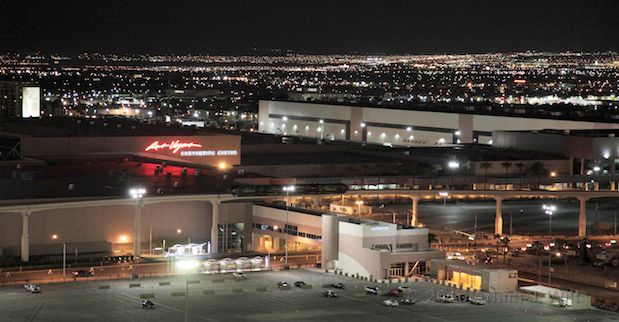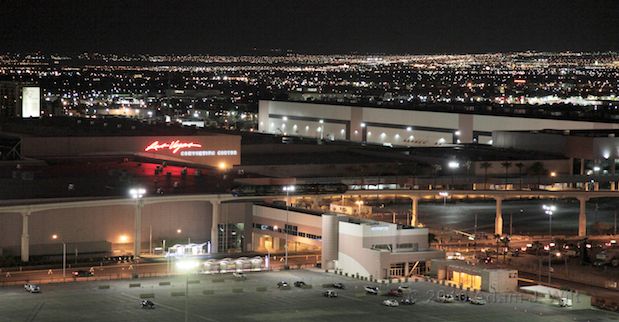
It looks so peaceful at night…
I only had two days at NAB this year, but I still came away with the strong impression of three major trends; call them the 3Ds…
- video-capable DSLRs everywhere;
- 3D production kit, ditto;
- the Democratization of digital cine cams.
Video-shootin’ DSLRs were freakin’ everywhere, and not just as demo cams on vendors’ stands. My guess is that half the video shot on the show floor was shot with DSLRs, with the majority being Canon 5D MkIIs and Canon 7Ds, though I also saw a few Panasonic GH1s in use. (The other half of the press seemed to be using Sony EX1s and EX3s with the occasional Panasonic HVX200 and HPX170 thrown into the mix. I didn’t see anyone lugging around a traditional 2/3″ broadcast cam during my two days at the show.)
Dozens of booths were showing DSLR-oriented support kits, follow-focuses (follow-foci?), and field monitors. Indeed, vendors of support systems who have typically done a land-office business kitting out 1/3″ and 2/3″ cameras were primarily featuring DSLR rigs in their booths; check out this video of Zacuto’s booth and see what I mean. Of course, Zeiss showing the Canon EF-mount Compact Prime CF.2 lenses and the EF-mount 15.5-45mm Lightweight Zoom did nothing to kill the buzz.
My absolute most favorite press conference announcement of all time.
3D was unavoidable. Whether it was stereo camera rigs, Panasonic’s single-piece AG-3DA1 camcorder, active and passive 3D displays, or 3D postproduction software, it was everywhere.
Vendors (hardware vendors especially) are looking at 3D as the Next Big Thing in consumer space, the must-have upgrade that will save everyone’s financial bacon. But no one I spoke to who wasn’t pushing product was quite so sanguine; it was either SMPTE’s Glen Pensinger or fellow filmmaker/journo David Leitner who summed it up best: “yes, they’re trying to sell it to us. But it’s not clear that we’re buying it.”
The 5.6″ SmallHD monitor has component and HDMI below; dual-link (!) SDI on top.
The democratization of digital cine cams was a lesser theme, but one that came from three directions (crikey, yet another 3D!) at once. From the high end, the Arri Alexa and the Aaton digital back for the Penelope 35mm camera bring top-quality, brand-name, not-some-weird-startup-in-Orange-County, large-format cine imaging down to the price of a 2/3″ Varicam or HDCAM camcorder. From the low end, those pesky DSLRs are busy doing to RED what RED did to the market as a whole a couple of years ago. And in the middle, both Sony and Panasonic announced large-format, interchangeable lens camcorders in the sub-$10,000 range.
(And RED? I’ve heard that they were walking around with a working prototype Epic, but I didn’t see ’em during my short stay. Disclaimer: we at Meets The Eye have three RED ONEs, and we’re currently debating how many Stage 2 Epic-Xs we’re going to go for.)
And if you don’t remove it?
Now, “democratization” is a loaded term in the industry: a dirty word to the grizzled graybeards, and word of power to the young turks.
The graybeards bemoan the arrival of cheap and cheerful new kit that allows dumb punks to horn in on formerly inaccessible territory; often the new kit has serious drawbacks, and the dumb punks are considered clueless about art, craft, culture, and on-set protocol.
This is, of course, true. Well, sometimes.
The young turks see the new kit as breaking down the artificial barriers that allow privileged insiders to maintain a cozy and exclusive club. Top-hatted visual-media capitalist pigs, beware: the workers can now own the means of production.
This is, of course, true. Well, sometimes.
Recession? What recession? There’s always something new(er) in Vegas.
Like it or not, the D-word is ubiquitous. Lucasfilm’s Rick McCallum uses it with respect to DSLRs. Panasonic uses it with respect to the AG-3DA1. I won’t even mention how many times it’s been used with respect to RED.
Change happens. Sometimes it’s for the better, sometimes it’s for the worse, but usually, it has elements of both. Depends how you look at it: does it threaten you, or enable you?
And consider: today’s young turks are tomorrow’s graybeards; the dumb punks tipping sacred cows with their DSLRs today will be toppled in turn tomorrow by some delightful, demoniacal, disruptive “democratizing” gear we can’t yet imagine.
Me? I like to watch.
The Magic Life in Image World: that pretty much sums up the NAB experience . . .
The other thing I took note of? It’s that tip of the iceberg represented by the HDAVS booth.
We’ve seen the knock-offs before: Chinese companies offering matte boxes and support gear, or stuff that looks just like Kino-Flo or Arri lighting gear, for a fraction of the price (and, often, at a fraction of the quality). I don’t think that explains HDAVS; they’re too far up the value chain, and things like their triple-well editing deck, with two E2 DataCam slots and one P2 card slot, show some evidence of Thinking Differently.
As The Economist explains, emerging markets aren’t just cheap places to build iPads and knock-off lighting fixtures any more; they’re coming into their own as sources of new, disruptive innovations. Expect to see more HDAVSes at future NABs: it’s no longer just about Japan, America, and Europe, and won’t be ever again. Tata nanoCam, anyone?
. . . yet when it’s all over, how quickly the magic is gone!
And at that, there was lots I didn’t see. Supermeet? Nope, though Stefan Sargent’s acerbic writeup makes me feel like I was there. RED party? I was already homeward bound (though with three RED ONEs, I’ve already drunk that Kool-Aid, thanks). Mac-based TV station systems; RAIDs, SANs, and NASes; transmitters; audio consoles; stock footage libraries and music beds; animation, mocap, and moco systems; OB vans, expandos, and helicopters; studio furniture, cabling, soundproof narration booths—it was all there… somewhere…
…maybe I’ll have time to see it all next year?
Man, I know just how he feels.
16 CFR Part 255 Disclosure
I attended NAB 2010 on a press pass, which saved me the registration fee or the bother of using one of the many free registration codes offered by vendors. I paid for my own transport, meals, and hotel.
No material connection exists between myself and the National Association of Broadcasters or the various exhibitors I report on (except as noted in my articles, when and if necessary); aside from the press pass, NAB has not influenced me with any compensation to encourage favorable coverage.
Stefan Sargent bought me breakfast one day at NAB. That didn’t influence me; I would have linked to his article anyway, because it’s good.

